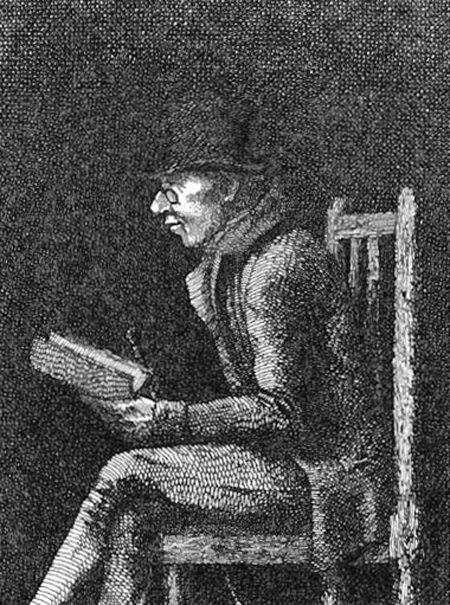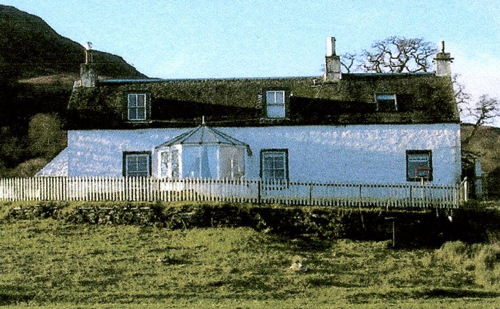HELENSBURGH and district is well known for renowned artists and architects . . . but it also has had notable poets.
This website provides coverage of two of the ‘greats’ of poetry, Cecil Day Lewis and W.H.Auden, who, by coincidence, were both teaching at Larchfield School in 1930. But their time here was short.

Literary giants such as Walter Scott penned verses set locally, but again, they had no real ties with the district. However this area has had for many years a proud, if unsung, history of nurturing poets.
This tradition continues to the present day, with poets like Catriona Malan and Elspeth Beaton producing works of quality, often through bodies such as Helensburgh Writing Circle, and Helensburgh and District Writers Workshop.
The most notable local poet of the past was Luss born and bred John Walker (right), who never entertained any plans to publish his poems.
It was only thanks to the Rev Dr John Stuart, DD, FRSE, minister at Luss, that this omission was finally rectified in 1817, when Walker was aged 78. It was another villager, Ian McEachern, who drew attention to the poet’s significance and uncovered information about his life.
Born in 1739, the son of a farmer who had the tenancy of a small farm, the Hill of Camstradden (top), near Luss, John Walker was brought up to follow in his father’s footsteps.
This came with the prospect of a life of hard and unrelenting physical toil and the uncertainty and mental pressure that went with an occupation where the margin between success and failure was very much linked to the vagaries of the weather.
Even so, he was very conscious that he was following in a long line of forebears who had tilled the same land before him.
He wrote: “I live on the same floor on which my ancestors have trod since time immemorial, and within the same walls and the same reeking roof under which my father lived, and I sleep on the same bed on which he died.
“I have lived, and do live, in the midst of a group of the best neighbours, who laugh at my eccentricities, and I laugh at them in return.”
An irrepressible sense of humour is a hallmark of his poems, and it is seldom far below the surface. He loved good company, and he was not averse to a strong beverage.
Records confirm the truth of his remarks on his ancestry. The Hearth Tax of 1693 lists a John Fucater and an Adam Fucater as householders at Hill of Camstradden Farm — and Walker is the Anglicised version of that Gaelic surname.
The generation at the time of the Hearth Tax was the last to use the old version, and Ian McEachern has established that John Fucater was the grandfather of the poet.
There are records of a settlement there at least as far back as 1550, but it is not known if Fucaters lived there at that early date. But the continuity since the Hearth Tax implies a very stable relationship between the Walker tenants and the lairds, the Colquhouns of Camstradden.
Walker’s writings make it clear that he had a great deal of warmth and respect for the Colquhoun lairds of his day.
Walker had only the most basic education, in any formal sense, so it is all the more remarkable that he acquired the ability to read and write in Gaelic, English, and broad Scots.
The preface to his book of poems, presumably penned by his sponsor, Dr Stuart, stated: “If the poems indicate a knowledge superior to the poet’s station, it has been entirely the fruit of his own assiduity and taste for reading.”
Walker married his sweetheart, Mary McFarlane, in 1772, and they had several children. Mary died in 1782, and five years later, John married Mary McLellan, and by her had more children, including Findlay, born c.1793.
Sadly Findlay died in 1798, and this prompted his father to compose a poem in his memory, which begins:
“‘Twas when the primrose hailed the infant year, when all was eye and all was list’ning ear,
“My sweet rosebud reclined his weary head, and here he lies among the silent dead . . .”
Findlay’s headstone in Luss churchyard also contains a verse in Gaelic, which was translated into English by a later minister at Luss.
Walker’s talent in several languages was to prove of great assistance to Dr Stuart, whose father, who was minister at Killin, had some years earlier embarked on the monumental task of translating the New Testament into Scots Gaelic, completed in 1767 with some help from his son.
The young man was motivated enough to take on the challenge of doing the same with the Old Testament. Perhaps unsurprisingly, this huge undertaking involved a team effort.
The Scriptures were treated as consisting of four parts. In parts one and two, Dr Stuart was the main translator, but he was supported by John Walker and the Rev James McLagan.
Part three was a sole effort by Stuart, and part four was translated by Dr John Smith of Campbeltown, but it was subsequently re-translated by the Rev Alex Stewart of Dingwall.
The fact that the relatively uneducated Walker was entrusted with taking part in such a demanding exercise speaks volumes for his abilities with languages. The Gaelic version of the Old Testament was published in 1801.
The likelihood must be that Stuart’s gratitude and respect for Walker’s help played a part in his sponsoring the 1817 publication of the poems. The volume has poems in standard English, in broad Scots, and in Gaelic.
There is something of an analogy with Robert Burns, in that while Walker’s poems in standard English are thoughtful and well-rendered, it is when using broad Scots that they really seem to come alive.
His choice of subjects was broad — predictably the world of farming and the countryside crops up, as in “The Gude Hairst” (Harvest) and “Loch Lomond” — but of special interest to students of the Comet steamship are two particular poems.
Henry Bell’s ground-breaking steamship took its name from the Great Comet of 1811, which held the record for being the longest-lasting recorded naked eye comet — around 260 days — until the Hale-Bopp comet of 1997.
Walker was an eye-witness to this event in the autumn of 1811, and of it he wrote:
“Hail! Stranger of the boundless space, I hope ye’re come in terms o’ peace,
Tho’ some forbode, they scarce ken what, An’ some say this and some say that,
Some dread a pest’lence in thy breath, And ca’ thee agent o’ grim death . . .”
As subsequent events showed, there was some truth in this comet as a harbinger of disaster, with the first Comet being wrecked at the Dorus Mor tidal race in 1820, while the second Comet was sunk after a collision with the steamship Ayr off Gourock in 1825, with great loss of life.
The poem continues, with Walker’s philosophical mind and sense of humour to the fore:
“As for mysel’. I’m no sae frighted, Nor led by whim nor second sighted,
For omens never break my rest, Nor am I fleyt for witch or ghaist . . .”
Walker is understood to have witnessed Bell’s Comet sailing on the Clyde. In his poem “Eighteen Hundred and Sixteen”, he reflects on a rapidly changing world of technology:
“An’ steam engines, by lan’ and ocean, immense in pow’r an’ quick in motion,
We’ve nae mair need o’ horse or sail, Or spade or graepe or fork or flail,
Or water-mill or pleugh or team, For ev’rything is done by STEAM . . .”
Walker’s poems are a valuable social document, commenting on the issues of the day. He was a man of his time, but today’s observer would view him as a fiercely patriotic unionist and royalist.
There are poems in praise of the great military leaders of the day, along with strong criticism of the French and the threat they pose.
For example, there is a poem which centres on the prospect of hundreds of French soldiers crossing the English Channel in a mighty fleet of balloons, but as so often is the case, you can detect his sense of humour bubbling through.
Even so, as the old saying goes about true words spoken in jest, he may also be reflecting a widespread and deep-seated fear of French military power and ambitions. On the other hand, unashamedly amusing in tone is a poem on the unpopular Window Tax.
The list of well over 400 subscribers to his book of poems is a fascinating social document in its own right. As one would expect, the landed gentry, local and otherwise, are prominent in the list, with the Colquhouns of Luss and Colquhouns of Camstradden taking quite a few copies.
Fellow farmers and also ministers are well represented. Businessmen feature, such as the Denny family of ship and boat builders. Famous buyers included James Watt, Walter Scott and Sir David Wilkie.
Wilkie is of particular interest. The artist is understood to have used Hill of Camstradden Farm as the setting for one of his works, where a collie dog watches over an infant, and it is known that he was a friend of the poet.
The addresses of subscribers included the West of Scotland, London and even several places abroad, such Nova Scotia and Jamaica.
Residents of Helensburgh took only a handful of copies, although a D.McFarlane took four copies — perhaps he was acting as an agent? Copies of the book could be purchased through agencies in Glasgow, Greenock, Edinburgh and London.
One curious aspect of Walker’s life is that the date of his death remains unrecorded.
A headstone in Luss churchyard, referring to him as “a local poet of some repute”, was erected in 1895 by Sir James Colquhoun, but neither a date of birth nor date of death is given.
Perhaps Sir James’s stone replaced a pre-existing one. There are a number of other Walker headstones in close proximity, usually a strong clue as to related burials, so the omission in the case of a famous son is surprising.
Walker’s passing is noteworthy in another way — his name is mentioned again on an unrelated headstone. An obelisk to the memory of Dr Stuart refers to the help given to him by Walker in his Gaelic translation of the Bible.
Such a comment would not have appeared had it not been the express wish of the minister, a remarkable man in his own right, and underlines the esteem in which he held the poet.





